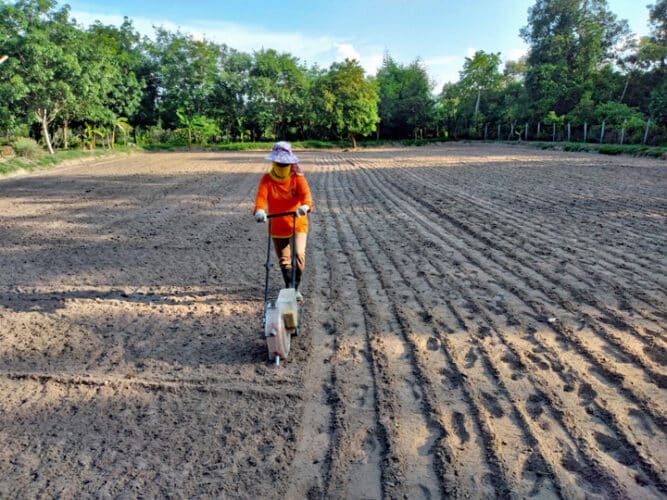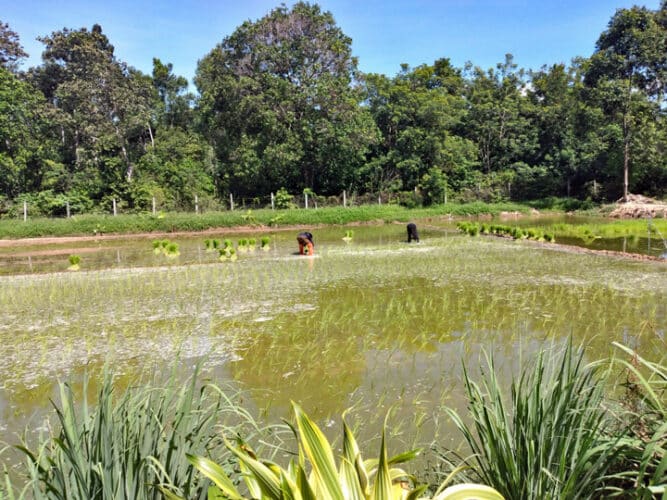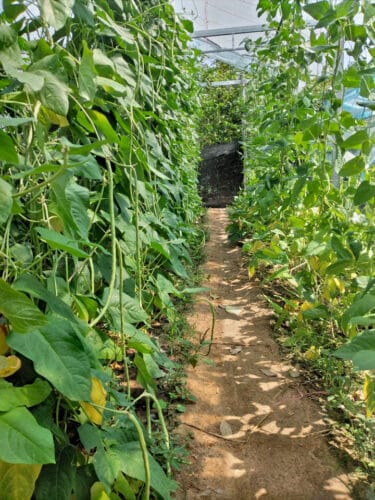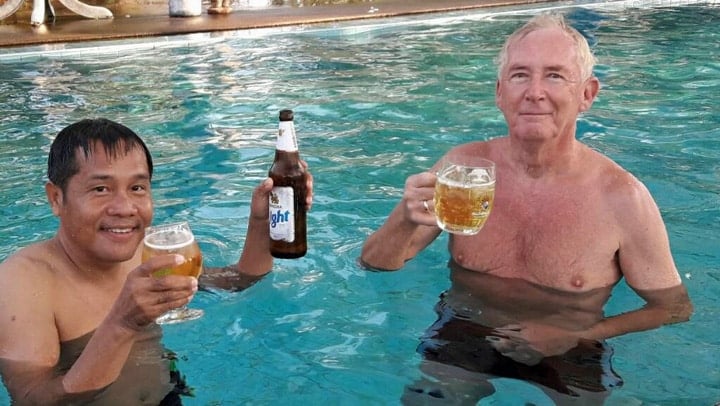Living like a Buddha in Thailand, part 2
In this part and in parts 3, 4 and 5 I will describe how I experience Isaan or rather Ubon. Ubon is of course not Bangkok with all its facilities. And no Pattaya, Hua Hin or Chiang Mai either. There are no mountains or beaches, but rivers and lakes. Also the climate is different, the people are different, the food is different and there are hardly any farangs here.
It also makes a difference whether you live in the city, in a residential area for the well-to-do Thai, in a farming village or, like us, just somewhere in the countryside. But how someone will experience Ubon will mainly depend on his own attitude and of course also on his possible partner. With all this I want to say that my experiences will offer little guidance for those who are considering also living in the Isaan, but it does of course give an idea of what life can be like here.
The farangs that live here all have their own colored perceptions. A farang who frequents Swensen's ice cream shop will soon think that the Isaan is populated with obese people. A farang who does his shopping in Central Plaza will soon think that all Isaaners have an expensive car. And the farang who only visits the cities and only stops at gas stations along the highways will think that the Isaan is full of 7-Elevens. I myself see the "reality" of course also colored, but rose colored glasses, no I don't wear them.
To get a broader picture of life in the Isaan, Thailandblog is of course the right place. See, for example, the stories of The Inquisitor who lives in a village in the Isaan. Or the stories of Bas and Charly who live in the city. Lung Jan also writes about life here in the Isaan and he lives just outside a village. Furthermore, there are of course numerous stories of farangs who occasionally visit the Isan.
But first I need to set something straight about the picture outlined in Part 1. With a lot of land (14 rai), a house, a swimming pool, a pond and an island with a kitchen and garden shed, many people might think that you have to be a millionaire for that, but fortunately that is not the case in euros (I have sometimes the idea that I am a millionaire….). That is, or rather was (15-20 years ago), not necessary. To name a few important items of expenditure: the house of 10 by 12 meters with one living room, one bedroom, one office and a simple bathroom (no kitchen) cost less than € 20,000 (helped by the favorable exchange rate of the euro at the time), the land less than €10,000, the covered swimming pool of 4 by 10 meters less than €20,000. Digging out the pond and thus also shaping the island was also not a huge expense because the excavated soil was in great demand for a fee (current price of a truckload of soil is THB 250). But of course there are additional costs. For example, the land had to be made liveable (but that did produce wood/charcoal), although we naturally left the most imposing trees. There was also no fence, no paths, no water drainage, no electricity, no telephone connection, no internet and no water supply. That all had to be arranged and built. We have also had two houses built for visitors from the Netherlands in particular. So there was still a lot of work to be done, mainly by my wife because I was only able to settle here permanently 10 years ago.
The land was so cheap because it was poor soil and dry, but also because it was Sor Por Gor land. Country with few rights but with obligations. The main obligation was to make it productive in an agricultural way. The land cannot be sold either. Incidentally, it is not so bad in practice with all those rules - at least here - because we have had it for 20 years and although part of our land has been expropriated because of the construction of an irrigation canal, we have received compensation for that, even slightly more than we paid for it.
A consequence of our choice for a wooded area was that we had no neighbors within a short distance. Over the years, some people – not farmers by the way – have come to live in our neighborhood, but the nearest house is still about 300 meters away. The village is just over a mile away. So villagers will not just drop by for a chat, only good friends. That has its advantages but also its disadvantages.

Sow rice
Ubon Ratchathani Province
Ubon is located in the Isaan halfway between the Gulf of Thailand and the South China Sea, bordering Laos and Cambodia, 130 meters above sea level. There are no mountains here, but you do have the rivers Mun and Mekong. The 1.800.000 people still live here for a large part of rice cultivation despite the soil being poor and more than one rice crop per year being possible only near the rivers. Earning extra money is therefore often a necessity, as a construction worker or in Bangkok for example.
My wife and I bought a piece of land in a wooded part of Ubon, which means that the soil was not very suitable for rice cultivation: too high and therefore too little water and, moreover, not exactly rich in fertilizers due to years of leaching. The first rice fields can only be found at about 600 meters and a nature reserve managed by scouts is located at a distance of one kilometer. That too, of course, is on poor soil.
climate
For example, information about the climate in Ubon can be found on Wikipedia (https://en.wikipedia.org/wiki/Ubon_Ratchathani#Climate). The rainy season cannot be compared to the often gloomy autumn in the Netherlands because the sun can also be seen regularly. Days without sun are fortunately rare and a period of say 3 days without sun occurs maybe once a year. In the rainy season you have strong tropical showers that sometimes last only a very short time and can be very localized, but at the end of the rainy season remnants of typhoons can come over and they can cause prolonged rain, sometimes more than a day. However, those extinguished typhoons are not frequent in Ubon, maybe one or two a year and are fortunately accompanied by little wind.
In the cold season the maxima are still above thirty degrees on average, but it can also be cold. The cold record for December is 9 degrees and also during the day the mercury - fortunately with great exception - sometimes cannot rise above 16 degrees. Now that will not deter most Dutch and Belgians, but when it is cold there is usually a lot of wind and that makes it unpleasant, even for the farang if that farang still wants to go outside with his shorts and t-shirt. And eating outside is no longer so attractive in the morning and evening. Having lunch in the open air is of course no problem because the sun usually shines anyway. The cold season is also characterized by drought. On February 20 of this year, rain fell for the first time since November 5 and that was also less than a millimeter.
In the warm season it can be really hot. A few years ago, the maxima were around forty degrees for weeks, but there are also years when the forty degrees are not reached. Up to 35 degrees I find it pleasant, but above that it is also a bit too much for me, at least at the hottest part of the day. Yet it has been many years since we have used the air conditioning, while we do have air conditioning in the bedroom and the study. When we go to bed, the outside temperature and also the temperature in the bedroom is often still 30 degrees, but with open windows and an open bedroom door, it is quite bearable in combination with a fan and I usually sleep excellently. I think my body has adapted to the climate and that, for example, my skin has better blood circulation now than when I was only in Thailand. A well-blooded skin is of course essential because your skin acts as a heat exchanger. People who are overweight and/or with blood vessel problems will probably not survive here without air conditioning in the warm season.

Plant rice
The air in Thailand is very humid and in the last month of October the dew point was constantly around 26 degrees, which means that the air temperature does not fall below 26 degrees at night either. A dew point of 26 degrees is extremely high. The skin can only stay “cool” if the perspiration moisture is removed quickly enough as vapour, and at that high humidity this is only possible if there is a reasonable air flow. And because there is often little wind in Ubon, even a fan outside is often not a superfluous luxury. And as long as you do not exert yourself and the temperature remains below 35 degrees, the sweat drops will evaporate so quickly that you will usually not be bothered by it. Only near 40 degrees or during exercise does the sweat run off you in jets.
Sometimes that much sweating is quite difficult. For example, if I go to my hairdresser on a sunny day on my bike at a deliberately quiet pace, I don't suffer from sweat. Only when I settle down in the hairdresser's chair do I sweat because she doesn't have air conditioning but only a fan that blows some air in my direction every now and then. If I go to the hairdresser by car (with air conditioning on) I don't suffer from it.
But of course that much sweating means that you have to drink a lot, a lot of water, in some months up to 3-4 liters a day. A cold beer should remain an exception and you should also leave soft drinks and fruit juices because otherwise the pounds will fly at you.
However, exercising is still possible and fortunately there is no risk of overheating if you only exercise for a short time (unless of course you were already overheated). With strenuous and prolonged exercise there is of course a great risk, especially if you drink too little water. During the half-time of a football match, the football players of the reserve players always receive a bottle of ice-cooled water and at temperatures above 35 degrees, the referee stops play during both the first and second half for a drink break. Sensibly, of course.
Tip: Your skin is smooth when it's dry and also when it's wet. But when it is clammy, the skin is rough and that makes electric shaving in Thailand difficult. Now there are also special electric razors that allow you to shave wet after applying shaving cream or shaving gel. I don't have such a device, but immediately after showering I shave effortlessly smooth with an ordinary electric shaver - cordless of course - while I have not dried off yet. I've been doing that for 10 years with no problems. I even have the impression that the blades stay sharp longer because wet hair is softer. After shaving, I open the shaving head and rinse it clean. Be careful that the water does not run into the shaver because that device is of course not waterproof.
Tip: When I'm in my armchair playing around with my PC I usually have the windows open and the fan on and I stay dry. However, the sweat on my back cannot evaporate and so I get a wet back and a wet chair. That's why I always put a bath towel over my chair to absorb the moisture.
Tip: In the cold season, if I'm not careful, my heels get chapped. Admittedly, the humidity is still high – at least much higher than in the Netherlands – but too low for my unprotected heels. Unprotected, because in Thailand I don't wear socks or closed shoes, which I did in the Netherlands. The solution to my fissure problem is simple: wear socks and/or apply a daily oily (Vaseline or beeswax) cream or remove calluses on a regular basis. I personally opt for the sockless solution.
Tip: In Thailand, the UV index is often extremely high (for example, see the following link with an hourly UV index forecast: https://www.accuweather.com/en/th/mueang-ubon-ratchathani/321409 /hourly-weather-forecast/321409?day=1). Burning (or worse) of the skin is therefore lurking, especially if you go on holiday with pale winter skin. Now the skin has various methods to prevent sunburn and repair damage, but in many cases it is still necessary to protect yourself against the UV light of the sun. And because UV light is strongly scattered, it comes from all sides, so on the water you run a lot of danger and on the beach even more because sand reflects UV light. In addition to that protection, it is also wise to look up the shade every now and then to let your skin recover. It is better to sit in the sun for 3*10 minutes than 1*30 minutes. During those rest periods, the skin can, for example, replenish its anti-oxidant stock because that stock can become exhausted due to the formation of radicals. I myself take 500 mg of vitamin C every morning and that ensures that I have an increased vitamin C concentration in the blood for the necessary hours so that deficiencies in the skin can be quickly supplemented. During the day I spend an average of 3-4 hours outside of which almost half of the time in the direct sun. Although I never use sunscreen, I have never burned here in all these years – I used to be during holidays – because I seek shade (indoors) 10-20 times every day, I walk in a wooded area (trees capture part of the UV light gone, even if you walk in the sun), because of course I have now turned a light tan after all these years and possibly also because of my vitamin C tablet and because my skin has good blood circulation nowadays, so that the anti-oxidant stock can be quickly replenished . So if you live permanently in Thailand, burning is easy to prevent. However, holidaymakers should be careful, especially those who visit the beach and especially the obese types (https://pubmed.ncbi.nlm.nih.gov/29541756/).
Remark. Too much UV light can not only cause you to burn and get skin cancer, for example, but your skin also ages faster. This aging manifests itself, for example, in reduced skin elasticity. For example, the reduction in skin elasticity on the top (the “brown” side) of the forearm is more than twice as fast as on the inside (the “white” side) of the forearm. An extra reason to wear it carefully in the sun.
Tip: Sunscreens have a Sun Protection Factor (SPF). A factor of 1 means no protection and a factor of 10 means you can stay outdoors for 10* as long as you burn compared to unprotected skin. But beware, the SPF is based on human testing (not animal testing) and the conditions under which the SPF is determined differ quite a bit from the practical conditions. For example, 2mg per square centimeter is used, which roughly corresponds to 40g of product if spread over the entire body. In practice, however, about half is used. During the test, the product is evenly distributed over the test surface, while in practice some spots will receive much more and other spots much less than 1 mg/cm2. Furthermore, in practice you always lose product through flakes of skin, through perspiration, through clothing or bath towel or through swimming. In short, in practice the protection is much less than indicated.
Tip: Some sunscreens contain substances that are harmful to coral reefs. Use "reef safe" sunscreen there because they are not (or less) harmful to the reefs.
Tip: Clothing naturally also protects against UV rays, but often insufficiently. In Australia clothing used to be, and perhaps still is, sold with the corresponding SPF value. That was useful information.
Tip: Use sunglasses with UV protection or a wide-brimmed hat. UV light is also harmful to the eyes, although fortunately the body has also “devised” countermeasures. But extra protection can't hurt.

garter
Air pollution
The quality of the air here is fair to good and in any case much better than in Bangkok. Incidentally, the air quality is not good throughout Isaan, especially in the west of Isaan. For more information see for example https://www.accuweather.com/en/th/mueang-ubon-ratchathani/321409/air-quality-index/321409. Visitors from Bangkok who have breathing problems can breathe a sigh of relief here!
There is little industry here, little traffic, but thunderstorms that cause ozone. Fortunately, the forests are not burned down here and there are no sugar cane fields in the immediate vicinity that are set on fire. However, there are controlled roadside fires here and there, rice fields with only some stubble that are set on fire, waste that is burned and charcoal production. The latter sometimes bothers us because charcoal is sometimes made a few hundred meters away from us. But yes, we also use charcoal…
Natural disasters
You don't have to be afraid of volcanic eruptions, earthquakes and tsunamis in Ubon. Strong winds only occur with local thunderstorms, but fortunately not with the blown-out typhoons that sometimes come across. Because houses are often not solidly built, roofs sometimes go up in the air with a thunderstorm and trees can of course also be blown over.
Rain can be a problem, but because the houses in the countryside are often a bit higher than the surrounding ground, this is only a problem in the city where the water cannot always be drained quickly and of course, especially along the Mun river, which sometimes flows outside. its banks. Roads can be impassable locally, but we have never experienced that we could not do groceries in the city, but the local Central Plaza was once more than a week inaccessible.
The next part is about the people of Isan and also about crime and corruption.
To be continued.



Many thanks, nice this extensive information!
Curious.
To make a long story short now it gets really exciting!!!!
The next part is about the people of Isan and also about crime and corruption.
To be continued.
Very nice to read, my compliments.
I want to compliment this piece. As a reader, I now have a real insight into daily life in a place in Thailand for the first time. Please continue because this is a really enjoyable read!